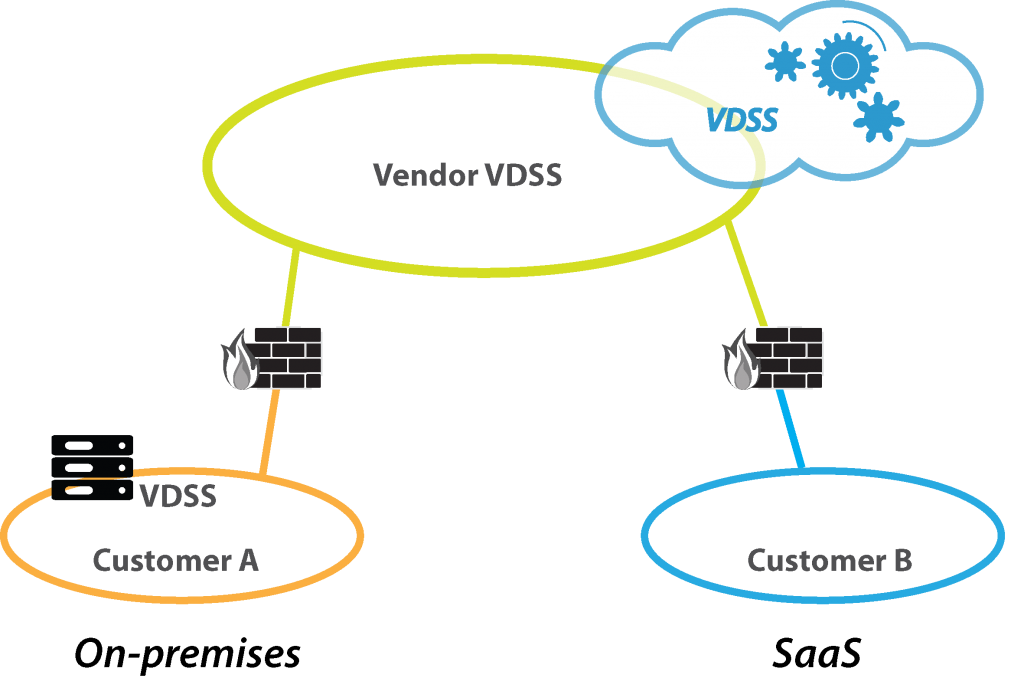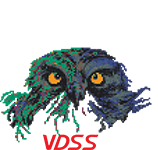On-premises and SaaS
A hybrid cloud mixes public and private clouds and they may also include on-premises legacy infrastructure.
This model helps a company achieve its technical and business objectives more effectively and cost-efficiently than on-premises, public or private cloud alone. VDSS fits seamlessly with all these environments.
VDSS as SaaS model is cost-effective, reliable, and completely free of any ongoing technical participation from the user. There are many factors to determine if SaaS is an ideal model for your company.
However, VDSS can also be installed on servers directly onto a company’s infrastructure. This type of setup is popular among corporations that have strict security and privacy policies requiring software to be installed internally on the company’s infrastructure.
____________________
____________________
VDSS as SaaS model
VDSS is offered as a cloud-based service. This service is provided by our vendors as a subscription model. As a result, you’ll have low initial costs for configuration. In addition to the cost factor, the minimal effort can also be decisive, because the maintenance, monitoring and backup tasks lie entirely with your vendor. VDSS as SaaS model is quick and easy to set up, so you can soon get started with automated route planning.
VDSS also offers you an easy scalability, you only pay for what you actually need and on demand increases, it can simply grow with the company.

Continuous updates which are carried out automatically, round-the-clock customer support from your SaaS vendor and remote access to services from any device.
____________________
VDSS as on-premises model
VDSS can also be offered as an on-premises model. The software & hardware infrastructural setup will be deployed and running from within your organization.
You have the complete control over the infrastructural setup. Data stays in your private network and nobody other than your team has access to the information.
VDSS will be installed in your own infrastructure, we will provide after sales integration and support services to help you out.
There is no need for internet access and there are no back doors or vendor connections needed.
____________________
What’s a Cloud
The cloud refers to servers that are accessed over the Internet, and the software and databases that run on those servers. Cloud servers are located in data centers all over the world. By using cloud computing, users and companies don’t have to manage physical servers themselves or run software applications on their own machines.
____________________
What’s SaaS
Software as a service, often abbreviated as SaaS, is also sometimes called software on demand. This is software that is offered as an online service. The customer does not have to purchase the software, but, for example, concludes a contract per month per user. The SaaS provider takes care of installation, maintenance and management, the user approaches the software over the internet with the SaaS provider.
____________________
SaaS the advantages
Quick to use: The user immediately has access to the application and is immediately ready to use. This saves a huge amount of time when installing and configuring new applications. Because many others use the same application, there is also little chance of problems occurring.
Relatively cheap: The license fee of the hardware and software of the SaaS applications is shared among all users. The SaaS supplier manages the environment and these costs are also shared among all customers who use the application.
Scalable: The SaaS vendor ensures that you get enough server capacity to adapt to your own usage.
Automatic upgrades: Innovations and improvements in the application are available to all users of a SaaS solution.
____________________
SaaS the disadvantages
Internet and performance: A SaaS solution cannot be used without internet access. A browser-based, externally hosted application can raise concerns about performance, which you will not have any control over yourself.
Security and access: Before entrusting sensitive data to a third party, issues such as identity and access control must be properly addressed. If you use multiple cloud services, you should take into account e.g. deactivating an ex-employee, this can be a headache file. The supplier should also have the appropriate controls and measures for the different types of data. This can be time consuming.
Integrating: Integrating multiple SaaS solutions is not always easy. This is particularly the case when the solutions are offered by different parties. Applications usually provide an ‘open API’, with which software can be linked together, but this is not always simple.
one size fits all: In general, SaaS is not really customizable. SaaS often works on the basis of a ‘one size fits all-principle’ and is therefore not really ‘customizable’. This is something you should take for granted if you choose SaaS.
____________________
What’s on-premises
Literally translated, on-premises in English means “on site” or “on location”. So when something is on-premises, the system is completely in-house, the software and data run on its own servers. The customer is responsible for the safety, availability and management of the system.
____________________
On-premises the advantages
Internet and performance: A SaaS solution cannot be used without internet access. A browser-based, externally hosted application can raise concerns about performance, which you will not have any control over yourself.
Security and access: Before entrusting sensitive data to a third party, issues such as identity and access control must be properly addressed. If you use multiple cloud services, you should take into account e.g. deactivating an ex-employee, this can be a headache file. The supplier should also have the appropriate controls and measures for the different types of data. This can be time consuming.
Integrating: Integrating multiple SaaS solutions is not always easy. This is particularly the case when the solutions are offered by different parties. Applications usually provide an ‘open API’, with which software can be linked together, but this is not always simple.
one size fits all: In general, SaaS is not really customizable. SaaS often works on the basis of a ‘one size fits all-principle’ and is therefore not really ‘customizable’. This is something you should take for granted if you choose SaaS.
____________________
On-premises the disadvantages
Initial costs: An on-premises setup requires in-house server hardware, software licenses and integration capabilities. Also IT employees on hand to support and manage potential issues that may arise. This doesn’t even factor in the amount of maintenance that a company is responsible for when something breaks or doesn’t work.
Knowledge and skills: Security is an essential requirement of any organisation when it comes to financial account, customer and employee details. Even though traditional on-premises seems more secure as it is in-house, there are multiple measures that need to be taken to fully maintain the security of the data.
